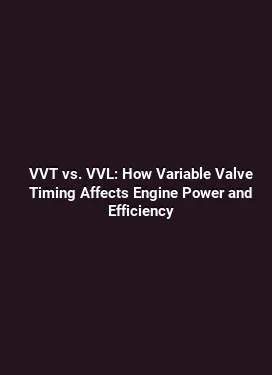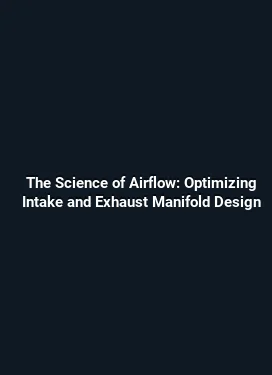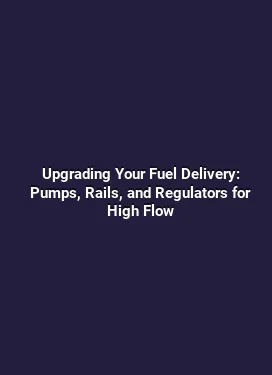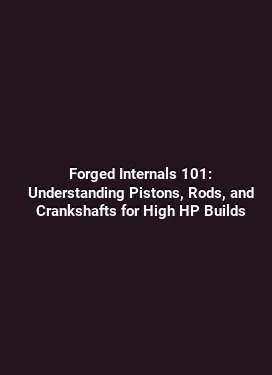ProCharger F-1A vs F-1C Supercharger: A Detailed Comparison for American V8 Engines
When chasing higher horsepower and stronger throttle response for American V8 powerplants, choosing the right forced induction option is essential. The ProCharger F-1A and F-1C are two prominent roots-style superchargers in the enthusiast and professional drag racing communities. Although both units are designed to deliver substantial boost and reliability, their differences matter for how a specific V8 platform will perform on the street, on the track, or in a hybrid setup that blends daily drivability with peak power. The goal of this analysis is to explore the operational philosophies, performance envelopes, install considerations, and tuning implications that distinguish the F-1A and F-1C so that a builder or racer can select the unit that best aligns with their goals, engine build, and driving expectations.
Overview of the F-1A and F-1C: Core Design Philosophy and Intended Use

F-1A: Broad Power Band and Intake Efficiency

The F-1A is designed to deliver strong, broad-curve boost suitable for a wide range of V8 configurations, from street cruisers to high-traction drag cars. It emphasizes consistent boost delivery across RPM, with a focus on lower intake restriction and efficient air handling to maximize torque across mid-range and upper RPMs. This makes the F-1A a favorable choice for builds that prioritize mid-range torque and overall street manners, while still providing substantial top-end power when the engine and fuel system are capable of supporting elevated boost levels.
Key attributes of the F-1A include a slightly larger impeller diameter relative to its sister unit, which helps maintain surge stability at higher boost pressures. The intake plenum and bypass path are tuned to minimize pressure fluctuations during abrupt throttle inputs, aiding drivability in street-driven V8 installations. In practical terms, an F-1A-equipped LS or modular V8 can exhibit strong launch characteristics with confidence-inspiring throttle response, while maintaining a smoother idle and consistent heat management under street conditions.
F-1C: Peak Power Orientation and Response
The F-1C is engineered with an emphasis on peak power delivery and rapid boost response at higher RPMs. This makes it a top candidate for dedicated race builds, where maximizing horsepower at the top end is the priority and the engine combination can tolerate higher boost pressures with tuned fuel and timing strategies. The F-1C typically employs a compact impeller profile and carefully chosen clearances to optimize volumetric efficiency at high RPM, which translates to impressive power gains in the upper rev range when used with appropriate fuel and intercooling support.
Enthusiasts who are targeting quarter-mile times or top-speed records often lean toward the F-1C for its ability to extract more air and generate higher pressure at the upper end, provided the rest of the system—fuel delivery, intercooling, exhaust, and engine internals—can sustain the added demands. The trade-off is that throttle response at very low RPMs may be less aggressive than the F-1A, particularly on naturally aspirated or mild turbocharged platforms where drivability is a focus.
Technical Differences and Their Impact on American V8 Powerplants
Boost Curves and Torque Delivery
Boost curves define how pressure rises as engine speed increases. The F-1A typically presents a more gradual boost ramp with a flatter torque curve early in the rev range. Practically, this translates to strong mid-range torque that remains linear and predictable as you roll into higher gears or shift through the RPM band. The F-1C, conversely, is tuned for a quicker rise to higher boost at elevated RPM, which yields a steeper torque ramp in the upper rev range. For a V8 engine paired with a well-designed fuel system and intercooler, this can produce significant horsepower at the top end, accompanied by a surge of torque when the engine hits the higher RPM sweet spot.
Air Handling and Intercooling Considerations
Both units rely on efficient air handling to maximize power while controlling intake temperatures. The F-1A’s path tends to favor consistent intake temperatures across a broader RPM window, aided by well-integrated intercooling and a stable bypass mechanism that reduces heat soak during sustained operation. The F-1C’s architecture is optimized for peak conditions at high RPMs, where the air charge is driven harder and cooler air is critical for maintaining performance and avoiding detonation under high-boost scenarios. Adequate intercooling, along with a properly sized radiator or dedicated air-to-air intercooler, is essential regardless of the chosen unit, as heat management directly influences power retention and reliability at high boost levels.
Mechanical Fitment and Drive System Implications
Physical fitment varies between the F-1A and F-1C due to differences in impeller offset, pulley ratios, and header clearance considerations. The F-1A commonly requires attention to belt alignment and tensioning systems because the larger impeller and drive gear train can influence parasitic drag and accessory loading. The F-1C, with its more aggressive high-RPM design, may demand careful attention to gear mesh precision, drive belt durability, and the potential for increased exhaust manifold heat loads in tight engine bays. For modern American V8 installations such as small-block Chevy, large-displacement modulars, and Hemi platforms, a precise bracketry and mounting approach is critical to maintain belt wrap and avoid accessory interference.
Performance Metrics: Power, Boost, and Responsiveness on V8 Platforms
Power Potential and Real-World Outcomes
When evaluating real-world power outcomes, the F-1A often yields a well-rounded sense of confidence, with increased torque that improves acceleration off the line and through gears on street-driven builds. The F-1C tends to maximize peak horsepower in controlled, track-focused applications where the engine tuning and fuel system are prepared for sustained high-boost operation. For hot-rodders running American V8s on a combination of street use and occasional drag strip sessions, the F-1A can provide a more forgiving and consistent experience, whereas competitors focusing on pure top-end performance might opt for the F-1C given a robust fueling plan and proper ignition strategies.
Throttle Response and Driveability
Throttle response under the F-1A setup is typically crisp, with a perceived boost onset that suits weekly street driving. In contrast, the F-1C can exhibit a delayed or more pronounced surge as boost builds to its apex, which can be thrilling on a track but may feel less immediate in daily driving. Tuning the fuel, ignition, and boost control is essential to harmonize response with the chassis for both units. Modern fuel systems, including capable injectors and high-flow fuel pumps, play a central role in ensuring the engine receives sufficient air and fuel at the required pressure, especially as boost climbs on larger displacement V8 engines.
Installation, Tuning, and System Integration
Assessment Before Installation
A comprehensive pre-installation assessment includes evaluating the intake manifold, coil and ignition system, fuel delivery, exhaust routing, and intercooler placement. A robust intercooling solution is a non-negotiable for both units on larger V8 builds, as heat management directly influences performance stability under sustained boost. It’s also important to verify the engine’s internal health, compression consistency, and the suitability of the crank and rods to handle elevated cylinder pressures. A well-prepared engine will respond more predictably to the boost profile offered by either unit, reducing the risk of detonation and mechanical failures during high-load operation.
Fuel System Requirements and Tuning Strategies
To exploit either supercharger effectively, the fuel system must be scaled to support the increased air delivery. This often means upgrading injectors, fuel pumps, and fuel rails, alongside a tuned ECU calibration that accounts for the higher air mass and altered volumetric efficiency. For street-friendly builds, a staged approach—beginning with modest boost and progressive upgrades to the fuel system and intercooler—helps maintain reliability. For track-focused projects, a more aggressive fuel strategy, including larger injectors and a high-capacity fuel pump with precise timing control, is typically required to sustain performance at high boost across the entire RPM band.
Intercooling and Heat Management
Intercoolers and charge-air cooling are pivotal for maintaining performance. The F-1A configuration benefits from a robust intercooler setup that minimizes heat soak during daily driving and helps preserve torque at elevated ambient temperatures. The F-1C setup demands even stricter thermal management to leverage its top-end potential; a well-designed intercooler, complemented by efficient ducting and airflow management, ensures that charge temperatures remain within safe limits during high-boost runs. Adequate heat management extends the life of the turbochargers, pistons, and valvetrain components under demanding duty cycles.
Maintenance, Reliability, and Long-Term Value
Durability and Component Quality
Both ProCharger units are built with attention to precision and reliability, using components designed to withstand the stresses of forced induction. Regular maintenance—such as inspecting belt wear, checking tension, monitoring charge-air temperatures, and ensuring the intercooler system remains free of leaks—helps sustain long-term performance. The choice between F-1A and F-1C may also reflect how a vehicle owner prioritizes reliability versus ultimate top-end power. A well-maintained vehicle with a measured boost strategy will experience fewer reliability issues and a longer service life from the forced induction system.
Cost of Ownership and Longevity
Initial cost, installation labor, and required supporting modifications influence the total cost of ownership. The F-1A, with its broader usability, may offer more value for a versatile build that spends a substantial amount of time on the street but still participates in occasional track events. The F-1C, while potentially more expensive due to higher-performance demands and supporting upgrades, can deliver superior power on demand for dedicated race setups. When evaluating value, consider the full stack: intercooler capacity, fuel system augmentation, engine internals, transmission compatibility, and chassis suspension tuning required to harness the power safely and effectively.
Real-World Scenarios: Choosing Between F-1A and F-1C for Specific American V8 Applications
Small-Block Chevy with a Street/Strip Blend
For a street-driven small-block Chevy aiming for mid- to high-10s in a quarter-mile, the F-1A provides approachable power gains with a smoother daily usability profile. The boost target can be tuned to avoid excessive torque that overwhelms the drivetrain, and a balanced cooling setup ensures consistent performance. If the plan is to push into more aggressive track use, some builders opt for the F-1C after ensuring the fuel system, intercooler, and transmission are fully upgraded to handle the elevated power output.
Ford Coyote Builds with Track Focus
In Coyote-based builds that routinely operate at high RPMs on the track, the F-1C can extract significant horsepower when paired with a precise ECU tune, robust intercooling, and a high-capacity fuel system. The top-end power potential can translate into faster trap speeds, provided the chassis, tires, and gear ratio selections align with the increased power. A careful plan for heat management and engine cooling is essential to maintain performance across multiple laps and prevent thermal throttling.
Chrysler Hemi Packages and High-Displacement V8s
High-displacement Hemis often benefit from the F-1A’s broad torque delivery, especially if street usability remains important. For dedicated race-oriented Hemis that push to the higher end of boost and RPM, the F-1C becomes a compelling option, given that the fuel and cooling infrastructure can sustain sustained high-boost operation. In both cases, ensuring the exhaust flow is optimized and the intake system is balanced helps to maximize the efficiency of the forced induction setup.
Practical Guidance: How to Decide, Plan, and Implement
Define Your Objective and Use Case
Clear goals—such as daily drivability with occasional track use, or primary track performance with limited street time—shape the choice between F-1A and F-1C. Consider the engine’s longevity, the supporting upgrades you are prepared to install, and how much risk you are willing to manage regarding heat and detonation under booster conditions. A well-scoped project plan helps avoid mismatches between the forced induction system and the rest of the vehicle’s drivetrain and cooling strategies.
Plan Supporting Upgrades and Tuning Phases
Implement a staged approach to upgrades: start with a baseline fuel system, intercooling (including ducting and heat exchangers), and a conservative boost target. Monitor charge-air temperatures, fuel trims, and ignition timing to ensure safe operation. As confidence grows, increment boost gradually while validating performance on a controlled dyno or track environment. Document data points for a reliable tuning archive that can guide future changes or upgrades.
Maintenance and Reliability Protocols
Establish a maintenance routine that includes belt inspection every 5,000–7,500 miles (or per use-case guidelines), coolant checks for the intercooler, and airflow verification through the radiator and intercooler core. Set up data logging for critical parameters such as air-fuel ratio, ignition timing, coolant temperature, and boost to detect anomalies early. This disciplined approach protects performance gains over the vehicle’s lifecycle and helps maintain consistent performance across multiple operating sessions.
Conclusionary Considerations Without a Formal Closing
Both the ProCharger F-1A and F-1C offer compelling paths to significantly enhanced power for American V8 engines. The F-1A tends to prioritize broad, user-friendly torque and steady performance across a wide RPM spectrum, making it a practical choice for street and light-track use. The F-1C targets higher-end performance with a focus on peak horsepower, suitable for dedicated race applications where the surrounding system (fuel, cooling, transmission) is fully prepared to sustain heavy boost. The decision hinges on how the vehicle is used, the level of supporting upgrades, and the owner’s tolerance for potential heat management challenges under sustained high-boost conditions.
In all cases, a thoughtful combination of efficient intercooling, robust fuel delivery, precise ignition control, and reliable drivetrain components is essential to realize the full potential of either supercharger unit while preserving long-term durability and drivability.






